Sonos Arc Ultra review: the ultimate Sonos soundbar?
The ultimate Sonos soundbar delivers exceptional sound – but connectivity still isn't where it should be and the competition is strong at this price point
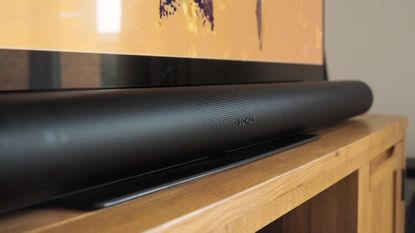
The Sonos Arc Ultra is arguably the best-sounding single-box soundbar solution on the market right now, delivering five-star audio and giving a decent bash at immersion through virtual surround processing. As an upgrade over the original Arc its bigger bass profile, clearer vocal presentation, and broader soundstage all make it worthwhile. However, if you want HDMI passthrough you still won't get that here – and this single HDMI port issue could be a deal-breaker for some (although, arguably for Sonos users with a lot of multi-room kit, it's probably not). If you're not mated to specifically buying Sonos, plenty of multi-box alternatives will offer truer surround packages for a similar asking price – such as the less elegant-looking but altogether more immersive Samsung HW-Q990D.
-
+
Can decode three-dimensional audio, adding height and immersion
-
+
Five-star sound quality that's a major audio upgrade for any TV
-
+
Bass upgrade over original Arc is noticeable
-
+
Plays nice with Sonos multi-room systems
-
-
Can't quite replace a multi-box surround system
-
-
Where's the HDMI passthrough port at?
-
-
App setup troubles at time of review
-
-
Sub 4 add-on costs a packet
Why you can trust T3
It was over 10 years ago that Sonos released its first-ever soundbar. Since then, the audio company has made significant headway into creating a full portfolio of soundbars – Arc, Beam, Ray – to appeal to most people's needs and, indeed, their TV sizes and setups.
Now, the Sonos Arc Ultra arrives as the spiritual successor to the Playbar, if you will, or more naturally as the audio-upgraded successor to the more recent Sonos Arc. The Ultra may look largely similar, but don't call it the 'Arc Gen 2' – as it's been redesigned and acoustically re-engineered to deliver more immersive sound, crisper vocal clarity and beefier bass.
I've been living with the Sonos Arc Ultra for a long weekend for this review – having recently tested a number of the best soundbars by comparison – to see if it's the ultimate soundbar upgrade. Amid Sonos' recent app struggles – which remained an initial setup gripe in my testing – it's otherwise great to see Sonos succeed with a single-box soundbar solution that truly sounds exceptional.
Sonos Arc Ultra: Price & Availability
The Sonos Arc Ultra is on sale now – review stock arrived later than the product's late-October shipping date, unusually – and you can grab the single-box solution for £999 in the UK, $999 in the USA, or AU$1799 in Australia.
Considering that the original Sonos Arc launched at £799 / $799 / AU$1399 – but was price-bumped shortly into its on-sale life to £899 / $899 / AU$1499 – that's not a giant leap for a soundbar with a lot more audio grunt to its name.
In the same breath, however, do consider that many multi-box soundbar competitors – including the superb Samsung HW-Q990D – have recently dropped in price to a similar or even lower asking price. And that true surround sound prospect from positional speakers may appeal even further if you're not mated to Sonos.
Sonos Arc Ultra review: What's New?
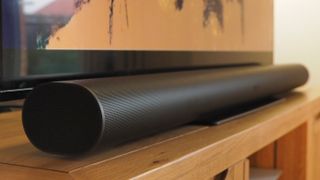
The Arc Ultra is fundamentally different to the original Arc – as the newer Ultra squeezes 14 speakers inside, arranged across seven tweeters, six mid-woofers and one 'Sound Motion' woofer. The earlier Arc model has eight woofers and three tweeters. Further catering for not only the high-end with that more significant array – useful for dialogue and vocals – but also a stronger focus on bass output shows the Ultra's upgraded position clearly.
The Arc was no stranger to three-dimensional sound output, with virtual Dolby Atmos surround achieved in a 5.0.2 output – that being five speakers catering for the front soundstage (centre, left and right stereo, side left and right), two upfiring for height, and while no sub is specified (hence the '.0'), any centralised bass would deliver a low-end equivalent to the centre – just lesser than sub-bass frequencies.

The Arc Ultra, however, upgrades that to a 9.1.4 output, arranged across nine front/side channels, four upfiring height channels, and one integrated woofer. You can still upgrade this by adding a sub (I have a Sonos Sub 4 also on review) and a pair of rear speakers (Sonos Era 300), but the channel arrangement remains fundamentally the same – it's still 9.1.4, just the crossover for low-end frequencies will be adjusted and the true rear channels will pick up an adjusted share of output.
As I say, to look at it's a case of spot the difference between the Sonos Arc and Arc Ultra. Interestingly, despite featuring more speakers, the Ultra is actually smaller overall – by around 1cm less tall, 0.5cm less deep – but measures a significant 117.8cm across, making it an ideal fit for the best 65-inch TVs. It'll be more than happy with 55-inch ones, too, or even going the other way there's no lacking in sound projection to handle 75-inch tellies and above.
Sonos Arc Ultra review: Design & Setup

When it came to setting up the Sonos Arc Ultra, the truth is it temporarily infuriated me. This might not be the experience everyone will have, but the Sonos app – sparse in its new look – located the soundbar and supposedly had it paired, but then wouldn't continue the setup. That therefore required a hard reset, before pairing would commence again – but then the app didn't like my Wi-Fi connection (possibly a specific new phone issue), despite router restarts and entering the correct password 10 times. Fortunately, as I also test the best phones as part of my job, I was able to fish out a recent Samsung handset, install the Sonos app on that, then get everything working. Phew.
Since everything has been connected from then – and there's an HDMI cable included in the box, so it'll play nice with an eARC connection – it's been really robust in its connection. I can use my TV remote to adjust the volume, so for day-to-day viewing, movies and music you needn't dive in and out of the app for the most part. Sonos does really need to get the app side of things back into check, clearly, but if you can forgive its current status – and, as I say, it's not always essential to engage with here – then the Arc Ultra is perfectly amicable.
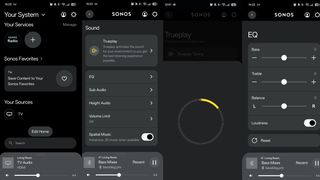
Where the app does present significant worth, however, is with the Trueplay Tuning – which the Sonos site says has been rebranded Quick Tune, but it's definitely not called that in the app at present – to measure a room's reflective qualities and adjust the sound profile accordingly. You can also manually further tweak bass and treble on a simple EQ slider (+/-10 apiece), enhance the height level (+/-10), apply loudness, select speech enhancement (off/low/medium/high), switch Spatial Music processing on or off, and if a separate subwoofer is connected, toggle its output level (+/-15).
I must also give a shout out to the Sonos Arc Ultra's physical design (hard as it is to shoot in dwindling UK sunlight) because it's undoubtedly one of the best-looking soundbars that I've set eyes on. The curved metal surface looks very high-end, the subtle Sonos logo is so delicately integrated front and centre, and the status light can be hidden through settings if you don't want any illumination – something home cinema enthusiasts will no doubt appreciate. Different colours signify different connections/problems, however, so I find it a useful visual reference.

Why, however, the Bluetooth button is hidden behind the soundbar – when there's a volume slider up top – is really beyond my comprehension. I suppose that, clearly, Sonos wants you to use Wi-Fi for multi-room rather than Bluetooth at all! I've used Bluetooth for getting some browser-based streams on my phone to the soundbar, though, and the connection is unquestionably solid, with no drop-outs.
There's also one significant caveat I must raise as to whether the Sonos Arc Ultra will be the soundbar for you: there's only one HDMI port. That means you can plug an HDMI cable into a TV's ARC or eARC slot and it'll handle sound effortlessly (yay). But there are no further ports, therefore no HDMI passthrough option (boo), as many other high-end soundbars offer, sometimes even into the multiples – and that might mean surrendering a 4K/120Hz slot on your TV as a result.
Those of us with multiple current-gen consoles – I'm yet to get my PS5 Pro – won't want to do that, especially if only two of your TV's HDMI ports are the 2.1 standard (which is the typical norm). This was a bugbear with the earlier Sonos Arc and it was widely expected the Ultra would 'fix' this – but, alas, it wasn't to be.
Sonos Arc Ultra review: Sound Quality
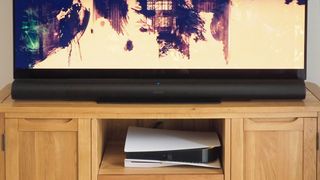
If you know the single HDMI port is perfectly fine for your setup then you'll certainly have no qualms about the Sonos Are Ultra's sound quality. Because, as one-box solutions go, I think it's arguably the best-sounding soundbar without the need for any bells or whistles extras. I've got the Sub 4 also connected, but I've toggled that off for portions of listening in the interest of balance. As a Sub 4 'speed review': it's brilliantly bassy, less fingerprint prone than previous models, but still bloomin' expensive.
The first thing that's clear about the Arc Ultra is how bass-capable it is without the need for a separate sub. I've loaded the bassiest of 4K Blu-rays that I own, Tenet, which has a notoriously bad sound mix – and, lo and behold, the bass smacks hard. But the Ultra isn't a one-trick pony: surprisingly the sometimes less-than-intelligible dialogue here punches through, with the Speech Enhancer option further coming to the rescue.
Dolby Atmos soundtracks certainly deliver a wonderful frontal soundstage that has height and width, with some great left-to-right bouncing of SFX – ricocheting bullets a clear example – that give a heightened sense of immersion. No soundbar with virtual processing is a match for a separates system, of course, as there are no speakers placed behind the listener here – but as confident three-dimensional output goes, I'm impressed by the spread of sound.

There's a great clarity to the overall delivery, the Arc Ultra never sounds stretched nor imbalanced at any volume level, dialogue doesn't sound flat nor sibilant. I did my dues and listened to plenty more with better sound mixes, but of course – from a weekend binge of The Diplomat on Netflix, to the latest sensation The Penguin on Sky/Now, and some stronger 4K Blu-ray options, with Bladerunner 2049 being a particular impressive outing.
This being a Sonos, it would be remiss to not feed it a variety of musical sources, of course, as many will be lured to this product because it plays nice with other Sonos multi-room products. My brother owns an Arc, Five (for the turntable addition) and Move 2, where I often am over and listening, and the Arc Ultra is steps beyond each and every one of those. Whether you're into rock, pop, ambient, acoustic, classic or whatever – the breadth of the Sonos Arc Ultra is never in question.
Sonos Arc Ultra review: Verdict
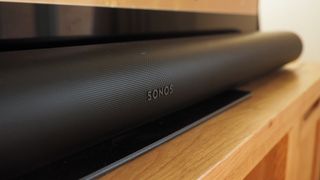
I think the Sonos Arc Ultra is arguably the best-sounding single-box soundbar solution on the market right now. Big statement indeed, but I've found the five-star audio and decent height and width through virtual surround processing to be impressive.
As an upgrade over the original Arc the bigger bass profile, clearer vocal presentation, and broader soundstage all make it worthwhile. Most people won't ever need to add a subwoofer to this setup, thanks to the enhanced bass, but you can – the Sub 4 (also in for test) is mighty, but also mighty pricey.
The Arc Ultra does come with caveats, however, namely that if you want HDMI passthrough then you're out of luck – and the single HDMI eARC slot here could be a deal-breaker for some. If you're not mated to Sonos, then plenty of multi-box alternatives offer truer surround for a similar asking price – such as the less elegant-looking but altogether more immersive Samsung HW-Q990D.
Overall, setting any app debacle issues aside, the Sonos Arc Ultra will be a five-star soundbar purchase for many – thanks to its epic sound quality. For others, however, those above caveats will hold it back from would-be perfection. Still, no other Sonos sounds better than this – the Arc Ultra is a major upgrade that I want to enjoy everyday.
Also consider
Still fixed on the idea of a Sonos but don't actually need a 'bar so big or bassy? Consider the original Sonos Arc as a step-down option, or, if you've got a TV that's 55-inch or smaller, then the Sonos Beam (Gen 2) does a decent job – and many in residential areas will find it the more amicable match.
If you can't live without HDMI passthrough and want separates included in the box then the subwoofer- and rears-included Samsung HW-Q990D is an unbeatable surround sound proposition that's in particular the best soundbar for Samsung TVs (thanks to also using the telly's speakers for even greater height – a Samsung-only feature though).
Upgrade to smarter living
Get the latest news, reviews, deals and buying guides on gorgeous tech, home and active products straight to your inbox.

Mike is T3's Tech Editor. He's been writing about consumer technology for 15 years and his beat covers phones – of which he's seen hundreds of handsets over the years – laptops, gaming, TV & audio, and more. There's little consumer tech he's not had a hand at trying, and with extensive commissioning and editing experience, he knows the industry inside out. As the former Reviews Editor at Pocket-lint for 10 years where he furthered his knowledge and expertise, whilst writing about literally thousands of products, he's also provided work for publications such as Wired, The Guardian, Metro, and more.
-
 HBO's massive new show has hidden features that are a must-watch
HBO's massive new show has hidden features that are a must-watchFan of The Penguin? Find out way more here
By Max Freeman-Mills Published
-
 Android 16 release date revealed and it's ridiculously early
Android 16 release date revealed and it's ridiculously earlyGoogle is stepping up the schedule for Android versions, which could be interesting
By Chris Hall Published
-
 Nvidia GeForce Now getting a game-changing update that won't please everyone
Nvidia GeForce Now getting a game-changing update that won't please everyoneAffects Performance and Ultimate members of the cloud gaming service
By Rik Henderson Published